Excerpts from Jim Conrad's
Naturalist Newsletter
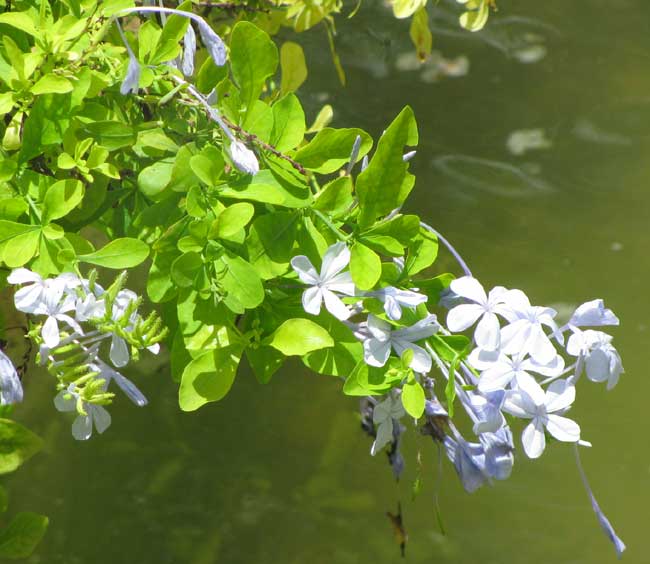
from the August 22, 2010 Newsletter issued from Hacienda Chichen Resort beside Chichén Itzá Ruins, central Yucatán, MÉXICO; limestone bedrock, elevation ~39m (~128ft), ~N20.676°, ~W88.569°
CAPE LEADWORT; as tropical garden border plant
At Hacienda Chichen's pretty entrance a reflecting pool is bordered by knee-high masses of a compact, weak-stemmed herb with bluish-white flowers, as shown above.
With those slender-tubed flowers each bearing five flaring corolla lobes, the average Northerner with a little garden-flower savvy would almost swear that it's some kind of phlox -- until noting what's shown below:
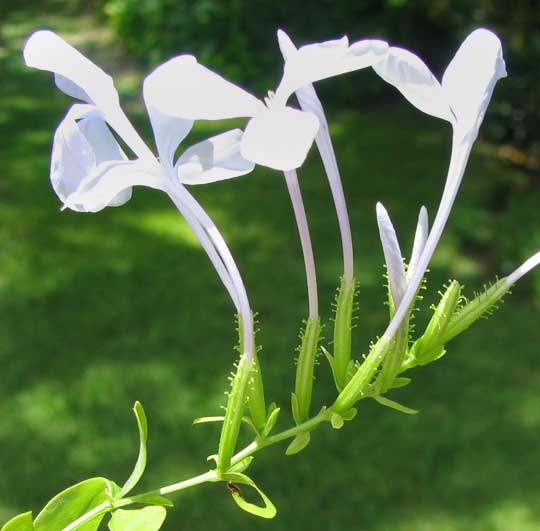
The slender, green calyxes below the bluish-white corollas are mantled with blunt, hairlike things. A close-up of those club-shaped "hairs" is shown at the right. Those are glandular hairs. If you touch the calyx with a finger you can feel its stickiness, and easily imagine what the hairs are for. If you're an insect looking for food and you're climbing the calyx, you'll get stuck among those hairs before you reach the flower's succulent sexual parts.
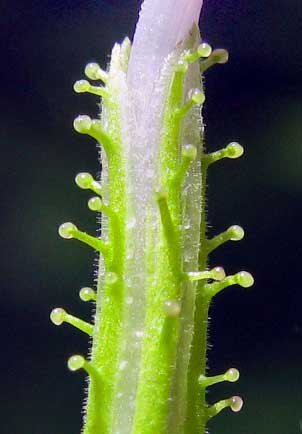
There's a genus of popular garden flowers recognized by the very fact that they look like phlox until you notice their glandular hairs. They're known as leadworts or plumbagos. The one at the Hacienda's entrance is the Cape Leadwort, PLUMBAGO AURICULATA, a native of South Africa but now planted worldwide in the tropics and subtropics, where it serves as a low hedge or ground cover. In the US sometimes it's grown in pots that must be taken inside during the winter.
"Leadwort" is something of a klutzy name for such a pretty plant. The name is based on the genus name Plumbago, bestowed by Linnaeus himself, which in Latin means lead. It's not clear what leadworts have to do with lead but I've read one theory that the plants were once used medicinally against lead poisoning.
Last November we reported on a weedy leadwort growing wild here at woods edges. That was Plumbago scandens, and you can compare it with its pretty African cousin at www.backyardnature.net/yucatan/leadwort.htm.
Entdry dated December 5, 2023, issued from near Tequisquiapan; elevation about 1,900m, (6200 ft), ~N20.57°, ~W99.89°; Querétaro state, MÉXICO
CAPE LEADWORT; as a large woody shrub
Eventually I realized that the plants profiled above presented just one appearance of Cape Leadwort. First, the Flora of North America describes the species' stems as erect, trailing, or climbing. Second, P. Hutchinson's 2005 The New Royal Horticultural Society Dictionary of Gardening explains that cuttings from larger plants easily can be rooted in warm, moist soils. Therefore, I'm thinking that the Hacienda Chichen plants probably had been recently planted from such rooted cuttings, for now in a walled-in, backyard garden in coolish highland central Mexico, I meet the woody plant shown below, which also is a Cape Leadwort:
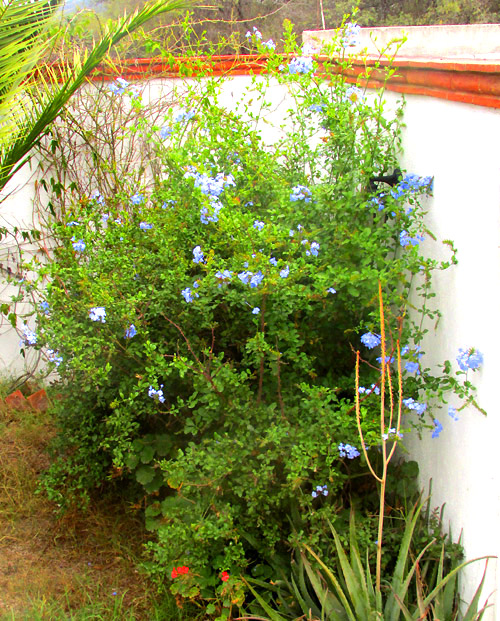
Various cultivars have been developed from the same species, so possibly that also accounts for differences. Supporting the idea that they're the same species, however, here are the above shrub's flowers:
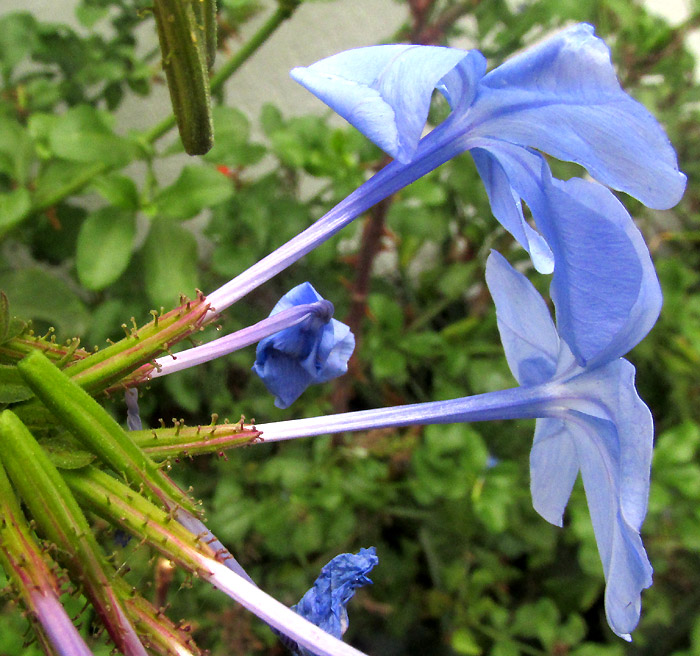
This time I got a picture indicating how sticky the glands are:
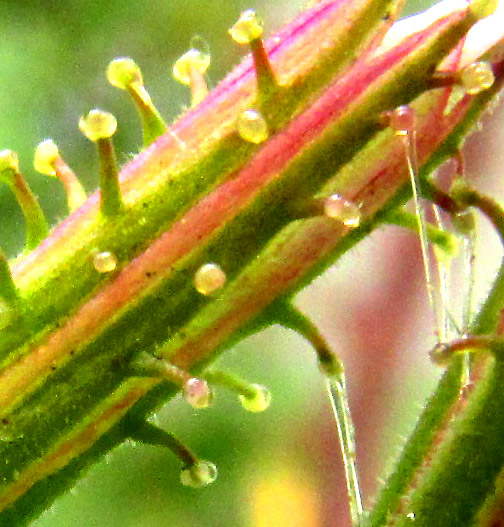
Above, the glands' adhesiveness is indicated by the stretching strands of mucilage-like gland stuff. That "stuff" remains of a somewhat mysterious nature. K. Singh and others in the 2019 study "Micromorphology and histochemistry of the secretory apparatus of Plumbago auriculata Lam." refer to the glandular hairs, which really aren't hairs, as glandular, uniserate trichomes. "Uniserate" describes the trichomes arrangement of growing in lines running up the calyx. After studying them in detail, the authors say that the trichomes bear a close resemblance to the digestive glands of the carnivorous plants known as sundews, genus Drosera. However, our shrub is not carnivorous, and in the end the authors say the glands need more study.
The above picture also shows calyxes more vibrantly colored than those in lowland tropical Yucatan. Probably our shrub receives more sunlight than the Yucatan plants; shaded plants in general tend to produce fewer pigments, thus are faded.
Since the Yucatan plants were profiled in 2010, much more information has become available on the Internet. For instance, now I learn that Cape Leadwort flowers occur in two forms, and each plant bears flowers of just one form. Flowers are either short-styled, with the stigma barely visible at the mouth of the floral tubes, while the anthers are held well above the mouth; or else they're long-styled, with anthers just barely at the tube's mouth, while the styles' stigmas project well above the mouths. The two forms help prevent the flowers from pollinating themselves. Here's the situation on our bush:
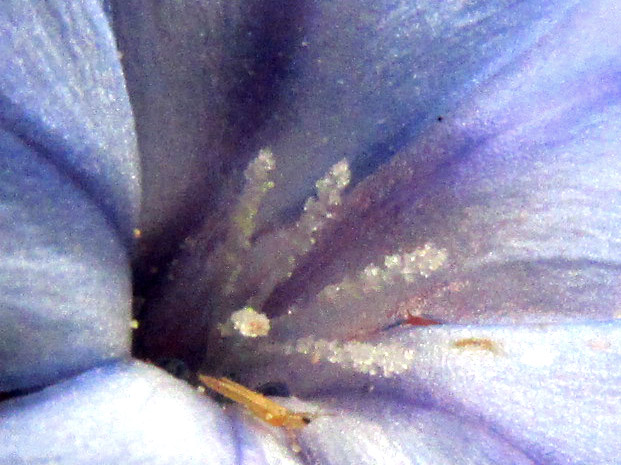
The five white, slender items issuing from the corolla mouth are stigmas, while the anthers lie in the shadows, so this flower is long-stiled. Species with short-styled and long-stiled morphs are part of a system for avoiding self-pollination. Other Plumbago species may or may not produce such morphs. With Cape Leadwort, there's also a not-well-understood "heteromorphic incompatibility system" which prevents self-fertilization, even if self-pollination takes place. Of course this means that if there's only one plant in the area, or more than one plant all of the same morph, no fertile seeds will be produced. By the way, the tiny white insect at the picture's bottom is a thrip of the subfamily Thripinae; thrips feed on fleshy corollas.

Also this time I pay more attention to the conspicuous white dots usually covering the undersurfaces of Cape Leadwort leaves, seen above. The white spots are dried residue issued by special excretory glands called both salt glands and chalk glands. The above-mentioned study by Singh and others found that the glands secrete calcium, sodium and traces of magnesium salts. It's been assumed that these glands help the plant live in salty soils or calcium-rich soils, though here our soil is neither salty nor particularly calcareous. The process must be important to the species, for the excretory process is extremely complex, at the cellular level involving mitochondria, ribosomes, endoplasmic reticulum, dictyosomes and vacuoles, according to Singh and others.